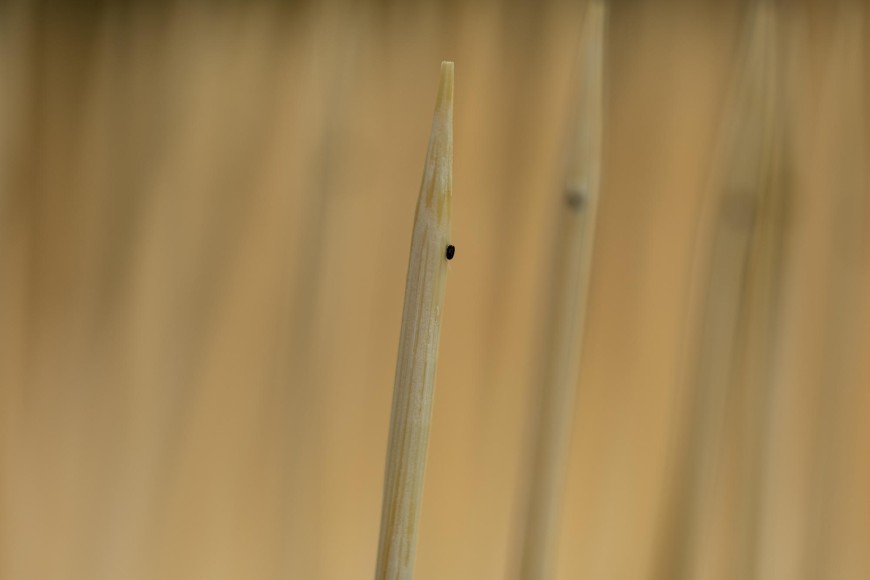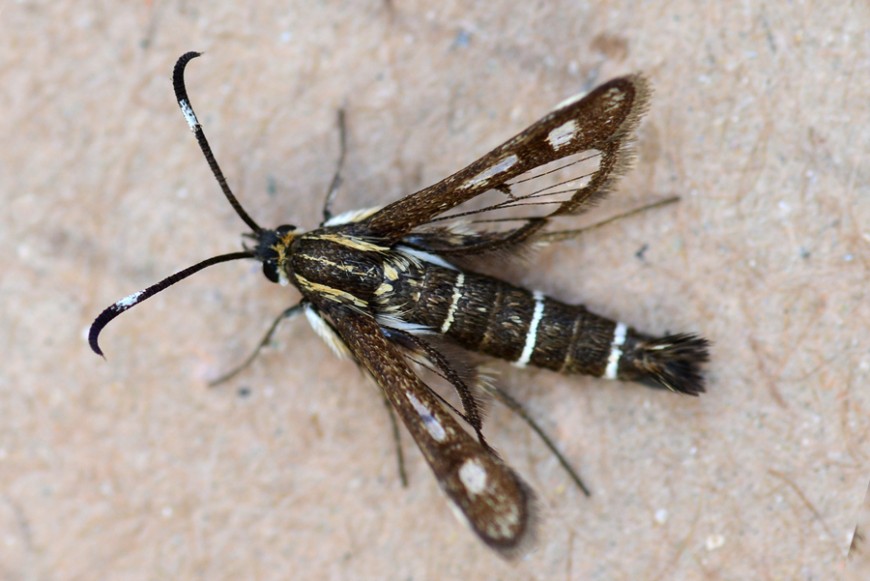Horehound clearwing moth
History in New Zealand
The horehound clearwing moth is native to Europe and was released in Australia as a biocontrol agent in the late-1990s. Permission to release the clearwing moth was granted by the EPA in 2018. It was imported from Australia into containment in New Zealand in late 2018 by Manaaki Whenua – Landcare Research and released soon after importation.
The clearwing moth together with a plume moth (Wheeleria spilodactylus) are beginning to noticeably reduce the vigour and density of horehound infestations in Australia. The plume moth was also released in New Zealand and is expected to complement the activity of the clearwing moth.
How would I find/recognise them and what is their lifecycle?
Adults are dark brown with fine white lines across the abdomen. The narrow wings have clear ‘windows’ and dark brown edges. They are about 10 mm long, with a wingspan of 12 to 14 mm. At rest, wings are folded back at a 40 degrees angle to the body. The black oval eggs are around 0.8 mm long and are laid singly between flowers and on leaves. Each female lays just under 100 eggs on average. Eggs hatch after 10-14 days.

Image: horehound clearwing moth egg glued to a toothpick.
Newly hatched larvae crawl towards the base of the plant and begin to burrow into stems. Larvae continue development inside the crown and root of the plant through autumn and become inactive during winter. In the native range and in Australia, usually only one larva per plant completes development. Plants in New Zealand appear to have bigger crowns and may support more than one larva per plant. Pupation takes place inside the plant. Pupae push up the tunnel formed by larval feeding and emerge from the lower stem or crown. Within 1-2 hours after emergence, adult females start to release a pheromone to attract males.
Image: horehound clearwing moth pupa.
The clearwing moth has one generation per year. The adults emerge in November-December and live 4-12 days. Adults can be difficult to spot. It may be easier to look for larval frass near exit holes at the base of plants. This frass is sometimes purple. Establishment in New Zealand has not yet been confirmed. There are no other insects on horehound that could be confused with clearwing moth.
How do they damage horehound?
Larvae feeding internally in the roots and stems disrupt the flow of water and nutrients and weaken the plant, ultimately leading to plant death. Once well established, the clearwing moth may limit horehound spread and density.
Will they attack other plants?
The horehound clearwing moth is highly host specific and is expected to only attack horehound (Marrubium vulgare) and no other plants.
How effective are they?
It is too soon to know what impact the horehound clearwing moth will have in New Zealand. The moth requires consistent high daytime temperature (above 30°C over 3-4 days) for mating to take place in spring, so it is anticipated that its range in New Zealand may be limited. In Australia, the moths have established and are continuing to spread even in cooler climates like in Tasmania, where they were not expected to establish. Anecdotal evidence suggests that the horehound clearwing moth and the horehound plume moth together provide satisfactory suppression of horehound in Australia, and no other agents are being pursued.
How can I get the most out of this agent?
If the clearwing moths establish at initial release sites, it would be worth helping to establish them in all areas where they are needed and where daytime temperatures in spring can remain consistently high. The clearwing moth is a strong flyer, but population build up is expected to be slow initially, because the moths only have one generation per year.
How do I select a release site?
Read Guidelines for selecting release sites for biocontrol agents.
How do I collect them for release at other sites?
Initial releases were made by gluing eggs onto toothpicks and inserting the toothpicks into cut stems of 2-3 years old horehound plants (one toothpick per plant). Once the moths are well established, it will be possible to dig up and transfer infested plants into new sites in late spring, shortly before adult emergence. At least 200 plants have to be dug up and transferred for each new release site.

Image: preparing horehound clearwing moth eggs for release.
Image: releasing horehound clearwing moth eggs on toothpicks into the field.
How do I manage the release sites?
Avoid any activities that will interfere with the clearwing moth, such as herbicide application. If you need to undertake control measures, then avoid the release site. Avoid grazing at the release site from November to end of February to prevent new eggs being eaten by stock.



